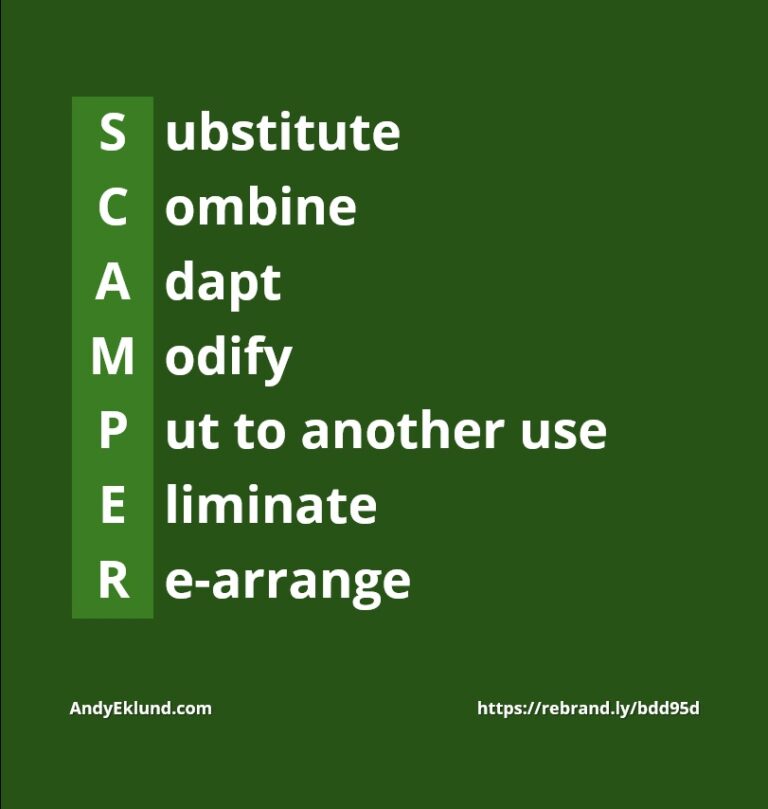SCAMPER is one of the most well-known brainstorm techniques.
The brainstorm exercise first appeared in Alex Osborn’s book Applied Imagination (1953). He outlined a series of challenge questions about a product or service to stimulate possible solutions, insights, perspectives or directions. The questions were grouped around a common active verb – such as Substitute or Adapt.

In the early 1990s, Bob Eberle, an author of books to increase creativity in children, simplified the original nine groups of questions into the clever anagram SCAMPER.
- Substitute
- Combine
- Adapt
- Modify (either Maximise or Minimise)
- Put to another use
- Eliminate
- Re-arrange (or Reverse)
How To Use SCAMPER
1. State the problem that is preventing the objective or utcome from being achieved.
2. Select one of the seven areas and ask questions to yourself / to your team to inspire new ideas, challenge your thinking, or curve off in a new direction.
3. Keep selecting a different letter until you generate a lot of ideas. Then, sort and organise to find your best ideas.
Remember the 90-10 Rule / Sturgeon’s Law!
One of the ‘laws’ that governs creativity – formally known as Sturgeon’s Law – means that in every brainstorm, 90% of what you generate won’t be usable. So, one of your final acts in any brainstorm is to sift through the total ideas and focus on the 10% where your best ideas will be.
In other words, generate the most ideas possible, good or bad. (Don’t worry in the brainstorm which is which.) By increasing the total size of the ideas, you also increase the 10% of the best ideas.
Explanations and Examples of SCAMPER
Here’s the original seven SCAMPER groups of questions. For each, I provided suggestions and examples for a brainstorm between a friend and I seeking new ideas through SCAMPER to add to her newly remodeled bakery, specificially what new variations could she make for her signature specialty: cupcakes.
S – Substitute
What else? Who else? Other people or roles? What other components, attributes, elements? Other materials or ingredients? Different approaches or steps? What about other places? Is there a different tone of voice or positioning?
Examples of Substitute
Could she substitute the ‘Australian culture’ for a different one? Thai cupcakes? Greek cupcakes? Could she substitute the shape of the cupcakes? Triangles? Squares? (“Cupsquakes”?)
C – Combine
Blending elements, assemblies or services? Combine ideas or purposes? Merge units? Forge a new ensemble or assortment? A new alloy?
Examples of Combine
Could she combine a dessert with an appetizer? Make the cupcakes savoury, not sweet? Perhaps adapt an existing recipe where the cupcakes could be suitable accompaniment for salads? Is there a way to add alcohol or liquor? Could she make a cupcake which was perfect for beer?
A – Adapt
Change its function? What else is this like? Is there another idea this one suggests? What could we copy from someone else? Whom could we emulate? Does the past offer a parallel to the future? Is there a new twist?
Examples of Adapt
Could she sell or cross-promote her cupcakes at other stores in her area? For example, you’d get a free cupcake with a $50 dry cleaning bill. Can she make a mobile cupcake stand, set-up outside of a local college, the local train stop, or the nearby movie theatre?
M – Modify … as in Maximise
What can we add? More time? Frequency? Can we make it stronger or faster? Longer, thicker, more value? Can we exaggerate it? Duplicate it? Multiply it?
Or, Modify … as in Minimise
What we reduce? Can we condense it? Make it lower, shorter, lighter? Split-up or make understated? Can we change meaning, colour, motion, sound, odor, form or shape?
Examples of Modify
Could she make tall cupcakes? Or really tiny cupcakes (made in thimbles)? Or the largest cupcake ever made in Australia?
P – Put to other uses
What new use does this have? If modified, what else will it do? Let’s say we put it in a new environment, industry or country: how would they use it? Perhaps we change audiences, what would they do it with?
Examples of Put to Another Use
There was a big dog park two blocks away. Could she make canine cupcakes? Could she make cupcakes to replace dinner rolls? Or cupcakes to eat at breakfast?
E – Eliminate
What can we streamline, omit or edit? Can we remove an existing attribute? Woiuld it make something entirely new, or justly different? Perhaps we might neutralise a specific attribute or element? Is there any way to simplify the idea? If reduced to its essential function, what’s left?
Examples of Eliminate
Could she drop the calories? Make them flourless? Frosting-less? Paper-less? Cupcake-less (all frosting!)
R – Rearrange … or sometimes Reverse
Can we interchange components? Can we re-order or reverse? How can we make them opposites? Turn the tables? Transpose cause and effect? Turn it inside out, upside down, right-side up?
Examples of Reverse
Could she make upside-down cupcakes? Can you make inside-out cupcake, with the filling on the outside and the cake on the inside? Could she make cupcakes with the frosting on the inside?
This turned out to be a popular article. In Part 2, I’ve added additional questions for each letter as additional help and support.
As always, let me know how you’ve used the exercise, or if you have any questions. Good luck!


No comment yet, add your voice below!